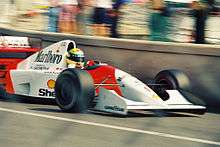McLaren MP4/7A
 | |||||||||
| Category | Formula One | ||||||||
|---|---|---|---|---|---|---|---|---|---|
| Constructor | McLaren International | ||||||||
| Designer(s) | Neil Oatley | ||||||||
| Predecessor | MP4/6B | ||||||||
| Successor | MP4/8 | ||||||||
| Technical specifications[1] | |||||||||
| Chassis | Carbon fibre monocoque | ||||||||
| Suspension (front) | Double wishbones, pushrods | ||||||||
| Suspension (rear) | Double wishbones, pushrods | ||||||||
| Engine | Honda RA122-E, 3,493 cc (213.2 cu in), 60° V12 NA, mid-engine, longitudinally mounted | ||||||||
| Transmission | McLaren transverse 6-speed semi-automatic | ||||||||
| Fuel | Shell | ||||||||
| Tyres | Goodyear | ||||||||
| Competition history | |||||||||
| Notable entrants | Marlboro McLaren Honda | ||||||||
| Notable drivers |
1. 2. | ||||||||
| Debut | 1992 Brazilian Grand Prix | ||||||||
| |||||||||
| Constructors' Championships | 0 | ||||||||
| Drivers' Championships | 0 | ||||||||
The McLaren MP4/7A was McLaren International's Formula One entry for the 1992 season, and a follow-up to their successful MP4/6 from 1991. The Williams-Renault combination was getting faster and more reliable, and became a formidable challenger to McLaren's dominance. McLaren used the MP4/6 chassis, designated MP4/6B for the slightly modified Honda RA122E engine, for the first two races of 1992. The all-new MP4/7A was expected for the Spanish Grand Prix, the fourth race of the year. Due to Williams' speed in pre-season testing, McLaren team principal Ron Dennis made the decision to bring the car out one race early, at the Brazilian Grand Prix. However, this was one month earlier than expected.
This was the first McLaren to use a semi-automatic transmission; it was a McLaren-designed electro-hydraulic unit with semi-automatic activation. The team's technology partner Techniques d'Avant Garde (TAG) helped with development. This system allowed the driver to keep his foot on the pedal, without lifting from it, since the throttle cable was replaced with an electronic sensor. It also controlled engine speed automatically during gear changes. [2]
A variant of the car, dubbed MP4/7B, featuring an experimental active suspension system, was introduced in testing for that year's Portuguese Grand Prix. It proved insufficiently reliable, and was not used for the remainder of the 1992 season.
Success
For the first time since 1987, McLaren failed to capture the Constructors' or Drivers' Championship title. It was therefore the first time the team had failed to win the championships with Honda power, as the years 1988 to 1991 had all been successful in this respect. However, five Grand Prix victories were recorded by the drivers: three for Ayrton Senna, in his fifth season for the team, and two for Gerhard Berger in his third and final season for McLaren before switching back to Ferrari for 1993. [3]

Complete Formula One results
(key) (results in bold indicate pole position, results in italics indicate fastest lap)
| Year | Team | Engine | Tyres | Drivers | 1 | 2 | 3 | 4 | 5 | 6 | 7 | 8 | 9 | 10 | 11 | 12 | 13 | 14 | 15 | 16 | Points | WCC |
|---|---|---|---|---|---|---|---|---|---|---|---|---|---|---|---|---|---|---|---|---|---|---|
| 1992 | Marlboro McLaren | Honda RA122-E V12 |
G | RSA | MEX | BRA | ESP | SMR | MON | CAN | FRA | GBR | GER | HUN | BEL | ITA | POR | JPN | AUS | 99* | 2nd | |
| Ayrton Senna | Ret | 9 | 3 | 1 | Ret | Ret | Ret | 2 | 1 | 5 | 1 | 3 | Ret | Ret | ||||||||
| Gerhard Berger | Ret | 4 | Ret | Ret | 1 | Ret | 5 | Ret | 3 | Ret | 4 | 2 | 2 | 1 |
* 9 points scored using the McLaren MP4/6B
Footnotes
- ↑ http://www.statsf1.com/en/mclaren-mp4-7a.aspx
- ↑ Source: Autocourse 1992-93, Hazelton Publishing, page 40.
- ↑ Source: Autocourse 1992-93, Hazelton Publishing, page 238.
| Wikimedia Commons has media related to McLaren MP4/7. |